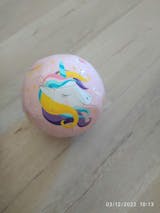
Glitter Shiny Sequins Unicorn Soccer Ball Size 3 Kids Toys with Pump and Mesh Bag for Girls Boys Toys for 3 4 5 6 7 8-Year-Old Girls


It’s all too common to see young children using oversized soccer balls which will have a negative impact on their development, so it’s important that players to feel comfortable and confident with the ball they’re using. Our soccer ball is the official ball with proper proportion for toddlers and is perfect for small hands to practice catching and throwing.

The inherent team aspects involved in soccer games for kids help to not only develop team orientation but to encourage better social interaction and communication. The young child learns to play by the rules and to take turns as required. They will also learn to experience winning and losing and how to handle those situations. Most importantly, as they play in a team environment they have the opportunity to interact with other children and to form friendships Learning to play soccer games with other kids helps them to build social skills and form friendships.

WHY DO NEW SOCCER BALLS ALWAYS SEEM SMALLER THAN USED SOCCER BALLS?
Newer soccer balls seem smaller because they actually are. When a ball is kicked, the pressure causes the threads to pull against the outside material covering the ball. With repeated kicks or hits, the soccer ball will expand slightly. Depending on the quality of the ball, it's been estimated that older soccer balls can be up to 20% larger than the same ball when it was new.

Use high quality rubber and toxic-free materials, designed to resist abrasion and last longer. The soft soccer balls use a rubber bladder for best air retention and machine-stitched with a soft touch and high durability. The softer material makes it a great option for kids to keep themselves from hurting themselves as they’re still learning how to kick the ball.

NOTICE:
1. Do not sit or stand on your soccer ball. This puts too much pressure on the seams of the ball and can cause it to warp or eventually break.
2. Check the pressure frequently
3. Slightly deflate the ball after playing. Reduce pressure when ball is not in use.
4. Please limit playing to smooth wooden floors, grass or grass. Surfaces like gravel and asphalt can damage the ball. Soccer balls, while tough, can be easily damaged by sharp and abrasive surfaces.






























